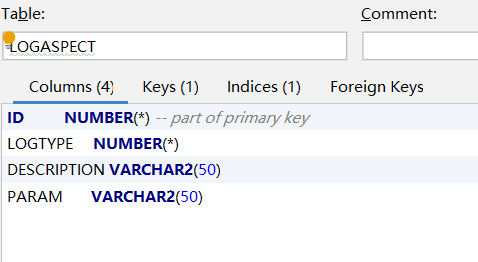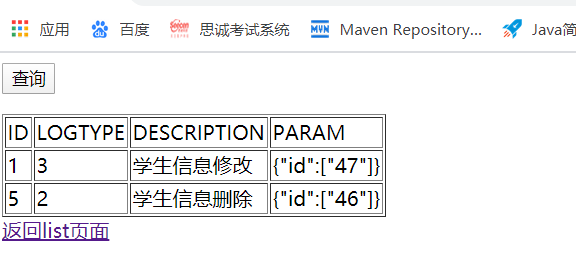1)在service层和mapper层中写一个插入方法和查询方法;
package entity;
public class Log {
private Integer id;
private Integer logtype;
private String description;
private String param;
public Log(){
}
public Log(Integer id, Integer logtype, String description, String param) {
this.id = id;
this.logtype = logtype;
this.description = description;
this.param = param;
}
@Override
public String toString() {
return \"Log{\" +
\"id=\" + id +
\", logtype=\" + logtype +
\", description=\'\" + description + \'\\\'\' +
\", param=\'\" + param + \'\\\'\' +
\'}\';
}
public Integer getId() {
return id;
}
public void setId(Integer id) {
this.id = id;
}
public Integer getLogtype() {
return logtype;
}
public void setLogtype(Integer logtype) {
this.logtype = logtype;
}
public String getDescription() {
return description;
}
public void setDescription(String description) {
this.description = description;
}
public String getParam() {
return param;
}
public void setParam(String param) {
this.param = param;
}
}
该写方法了
1、logService.java页面;
public interface LogService {
int insert(Log log);
List<Log> findAll();
}
2、logServiceImpl.java页面;
@Service
public class LogServiceImpl implements LogService {
@Autowired
private LogMapper logMapper;
@Override
public int insert(Log log) {
int i=logMapper.insert(log);
return i;
}
@Override
public List<Log> findAll() {
List<Log> logs=logMapper.findAll();
return logs;
}
}
3、logMapper.java页面:
public interface LogMapper {
int insert(Log log);
List<Log> findAll();
}
4、logMapper.xml页面;
<?xml version=\"1.0\" encoding=\"UTF-8\"?>
<!DOCTYPE mapper PUBLIC \"-//mybatis.org//DTD Mapper 3.0//EN\" \"http://mybatis.org/dtd/mybatis-3-mapper.dtd\">
<mapper namespace=\"mapper.LogMapper\">
<insert id=\"insert\">
<selectKey keyProperty=\"id\" resultType=\"integer\" order=\"BEFORE\">
select seq_logaspect.nextval from dual
</selectKey>
insert into logaspect(id,logtype,description,param) values (#{id},#{logtype},#{description},#{param})
</insert>
<select id=\"findAll\" resultType=\"entity.Log\">
select * from logaspect
</select>
</mapper>
5、由于我们打印日志是通过切面,所以我们写一个切面类;
package aop;
import com.fasterxml.jackson.core.JsonProcessingException;
import com.fasterxml.jackson.databind.ObjectMapper;
import entity.Log;
import entity.Student;
import org.apache.log4j.LogManager;
import org.apache.log4j.Logger;
import org.aspectj.lang.JoinPoint;
import org.aspectj.lang.Signature;
import org.aspectj.lang.annotation.Aspect;
import org.aspectj.lang.annotation.Before;
import org.aspectj.lang.annotation.Pointcut;
import org.aspectj.lang.reflect.MethodSignature;
import org.springframework.beans.factory.annotation.Autowired;
import org.springframework.stereotype.Component;
import org.springframework.web.context.request.RequestContextHolder;
import org.springframework.web.context.request.ServletRequestAttributes;
import service.LogService;
import javax.servlet.http.HttpServletRequest;
import javax.servlet.http.HttpSession;
import java.lang.annotation.Annotation;
import java.lang.reflect.Method;
import java.util.Map;
@Component//对象由spring管理
@Aspect//切面注解
public class LogAspect {
@Autowired
private LogService logService;
private static final Logger LOGGER = LogManager.getLogger(LogAspect.class);
//定义切入点,切入到添加了LogData注解的方法上
@Pointcut(\"@annotation(aop.LogData)\")
public void pointCut(){
}
/**
* 记录日志的切面方法
* 在该方法中定义统一的日志记录逻辑
* @param joinPoint
*/
@Before(\"pointCut()\")
public void log(JoinPoint joinPoint){
System.out.println(\"进入日志Aspect\");
//获取到方法签名
MethodSignature signature= (MethodSignature) joinPoint.getSignature();
//获取到连接点方法对象
Method method=signature.getMethod();
//获取方法上面特定的注解
LogData annotation=method.getAnnotation(LogData.class);
LogType logType=annotation.logType();
String description=annotation.description();
LOGGER.info(\"获取到注解内容:logType=\"+logType.getType()
+\",description:\"+description);
//aop中获取request
ServletRequestAttributes requestAttributes= (ServletRequestAttributes) RequestContextHolder.getRequestAttributes();
HttpServletRequest request=requestAttributes.getRequest();
HttpSession session=request.getSession();
//获取操作人
Student student= (Student) session.getAttribute(\"student\");
//获取请求数据
Map<String,String[]> parameterMap=request.getParameterMap();
//将对象转换成json字符串==>存储到请求数据字段中
//jackSon json字符串操作
ObjectMapper objectMapper=new ObjectMapper();
try {
String s=objectMapper.writeValueAsString(parameterMap);
LOGGER.info(\"请求数据:\"+s);
Log log = new Log();
log.setLogtype(logType.getType());
log.setDescription(description);
log.setParam(s);
logService.insert(log);
} catch (JsonProcessingException e) {
e.printStackTrace();
}
//todo 将日志信息保存到数据库 LogController service mapper jsp
}
}
6、写一个loglist.jsp页面来展示信息;
<%@ page contentType=\"text/html;charset=UTF-8\" language=\"java\" isELIgnored=\"false\"%>
<%@ taglib prefix=\"c\" uri=\"http://java.sun.com/jsp/jstl/core\" %>
<html>
<head>
<title>用户列表</title>
</head>
<body>
<form action=\"${pageContext.request.contextPath}/user/selAll\">
<input type=\"submit\" value=\"查询\">
</form>
<table border=\"1px\">
<thead>
<tr>
<td>ID</td>
<td>LOGTYPE</td>
<td>DESCRIPTION</td>
<td>PARAM</td>
</tr>
</thead>
<tbody>
<c:forEach var=\"log\" items=\"${logs}\">
<tr>
<td>${log.id}</td>
<td>${log.logtype}</td>
<td>${log.description}</td>
<td>${log.param}</td>
</tr>
</c:forEach>
</tbody>
</table>
<a href=\"${pageContext.request.contextPath}/user/list\" rel=\"external nofollow\" >返回list页面</a>
</body>
</html>
7、最后,我们写一个控制层的方法;
package controller;
import aop.LogData;
import aop.LogType;
import com.github.pagehelper.PageHelper;
import com.github.pagehelper.PageInfo;
import entity.Log;
import entity.Student;
import mapper.StudentsMapper;
import org.apache.log4j.LogManager;
import org.apache.log4j.Logger;
import org.springframework.beans.factory.annotation.Autowired;
import org.springframework.stereotype.Controller;
import org.springframework.ui.Model;
import org.springframework.ui.ModelMap;
import org.springframework.web.bind.annotation.ModelAttribute;
import org.springframework.web.bind.annotation.RequestMapping;
import org.springframework.web.bind.annotation.RequestParam;
import service.LogService;
import service.StudentService;
import javax.servlet.http.HttpServletRequest;
import javax.servlet.http.HttpSession;
import java.util.HashMap;
import java.util.List;
/**
* 控制层调service,service调dao层
*/
@Controller
@RequestMapping(\"/user\")
public class UserController {
//定义日志对象
//private static final Logger logger= LogManager.getLogger(UserController.class);
@Autowired
private StudentService studentService;
@Autowired
private LogService logService;
@RequestMapping(\"/list\") //@ModelAttribute(name = \"params\") :向request域中存值
public String list(ModelMap modelMap,@RequestParam HashMap<String,Object> map){
//定义debug级别的日志
//logger.debug(\"前台传递的查询条件:\"+map);
//logger.info(\"info级别日志:\"+map);
System.out.println(\"前台传递的查询条件:\"+map);
//List<Student> students = studentService.findAll();
// List<Student> students = studentService.findByMap(map);
// modelMap.put(\"students\",students);
PageInfo<Student> page = studentService.findByPage(map);
//记录error级别日志
//logger.error(\"查询到分页数据:\"+page);
System.out.println(\"查询到分页数据:\"+page);
modelMap.put(\"page\",page);
modelMap.put(\"params\",map);//将查询条件回传到页面,用于回显查询条件
return \"list.jsp\";
}
@LogData(logType = LogType.DELETE,description = \"学生信息删除\")
@RequestMapping(\"/delete\")
public String delete(Integer id){
studentService.delete(id);
return \"redirect:list\";
}
@LogData(logType = LogType.UPDATE,description = \"学生信息修改\")
@RequestMapping(\"/update2\")
public String update2(Integer id,ModelMap modelMap){
Student student = studentService.selectById(id);
modelMap.put(\"student\",student);
return \"update.jsp\";
}
//根据是否存在id值,来判断是执行新增还是修改操作
@RequestMapping(\"/update\")
public String update(Student student){
studentService.update(student);
return \"redirect:list\";
}
@LogData(logType = LogType.INSERT,description = \"学生信息新增\")
@RequestMapping(\"/insert\")
public String insert(Student student){
studentService.insert(student);
return \"redirect:list\";
}
@Autowired
private StudentsMapper studentsMapper;
@RequestMapping(\"list2\")
public String list2(ModelMap modelMap){
PageHelper.startPage(1,5);
List<Student> students=studentsMapper.selectAll();
modelMap.put(\"students\",students);
PageInfo<Student> pageInfo=new PageInfo<>(students);
System.out.println(pageInfo);
return \"list.jsp\";
}
@RequestMapping(\"/selAll\")
public String findAll(ModelMap modelMap){
List<Log> logs = logService.findAll();
modelMap.put(\"logs\",logs);
return \"loglist.jsp\";
}
}
测试结果,我们出来的页面效果是:
即说明打印日志成功了;
以上就是本文的全部内容,希望对大家的学习有所帮助,也希望大家多多支持自学编程网。















